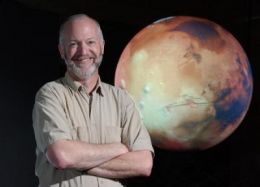NASA selected the University of Colorado at Boulder’s Laboratory for Atmospheric and Space Physics (LASP) to lead a $485 million orbiting space mission slated to launch in 2013 to probe the past climate of Mars, including its potential for harboring life over the ages.
The team, led by CU-Boulder’s LASP, will design, build, and operate the Mars Atmosphere and Volatile Evolution mission, or MAVEN. Carrying three instrument suites, the spacecraft will probe the upper atmosphere of Mars and its interactions with the Sun, said LASP Associate Director Bruce Jakosky, principal investigator for the mission.
MAVEN will be the second mission of NASA’s Mars Scout program, a recent initiative by the agency for smaller, lower-cost spacecraft. In 2007, NASA launched the first Mars Scout Mission, the Phoenix mission that is now operating on the surface of Mars. The multi-phase MAVEN proposal by LASP was 4 years in development.
Scientists will use MAVEN data to determine what role the loss of volatile compounds — including carbon dioxide, nitrogen dioxide and water — to space from the martian atmosphere has played in its evolution, said Jakosky. The results should provide insight into the history of Mars’ atmosphere and water.
“We have an outstanding mission that will obtain fundamental science results for Mars,” said Jakosky, an internationally known Mars expert. “We have a great team and we are ready to go.”
MAVEN’s three instrument suites include a remote sensing package built by CU-Boulder’s LASP that will determine global characteristics of the upper atmosphere. A particles-and-fields payload built by the University of California, Berkeley, with support from LASP and NASA’s Goddard Space Flight Center, contains six instruments that will characterize the solar wind, upper atmosphere and the ionosphere — a layer of charged particles very high in the martian atmosphere.
The third instrument suite, a Neutral Gas and Ion Mass Spectrometer provided by NASA’s Goddard Space Flight Center, will measure the composition and isotopes of neutral and charged forms of gases in the martian atmosphere.
Lockheed Martin, based in Littleton, Colorado, will build the MAVEN spacecraft and also will carry out mission operations for MAVEN. NASA’s Jet Propulsion Laboratory will navigate the spacecraft. LASP will provide science operations and data packaging and NASA’s Goddard Space Flight Center will provide management and technical oversight for the mission.
Most planetary scientists believe Mars lost most of its atmosphere several billion years ago. The MAVEN orbiter will study current atmospheric loss with emphasis on the role of the solar wind, including its rapidly moving charged particles and magnetic field that may be responsible in large part for the current atmospheric conditions on the Red Planet, Jakosky said.
“Understanding planetary atmospheres, including their present state and their evolutionary history, has been a mainstay of LASP’s research goals for over four decades,” said LASP Director Daniel Baker. “There is a proud tradition at the university to define the key scientific questions about other planets, to devise experiments to answer those questions, and then to lead research programs that fly the experiments and analyze the results.”
The MAVEN science team includes three LASP scientists heading instrument teams — Nick Schneider, Frank Eparvier and Robert Ergun — as well as a large supporting team of scientists, engineers and mission operations specialists.










